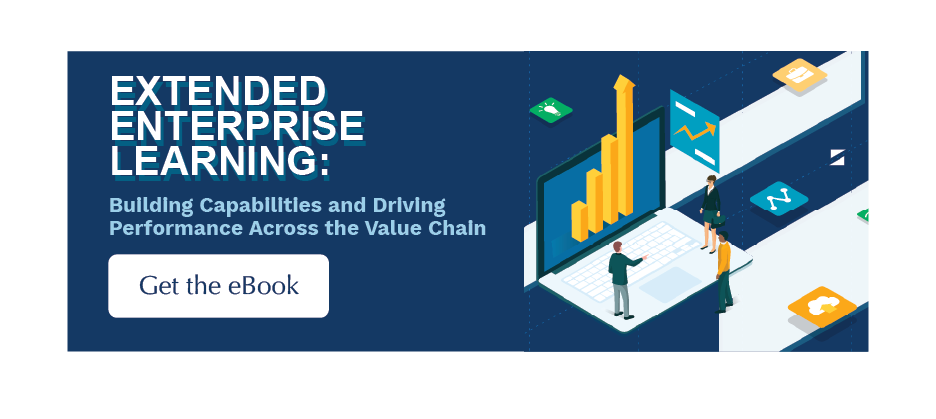Personalization of a training program can seem like a huge undertaking when considering the size and scale of your enterprise. When you are looking at the training needs of hundreds of different roles across thousands of partner employees, ensuring that each one has a personalized touch can feel daunting.
But, it’s not as difficult as it may seem, and while it may require some work up front, the benefits of personalizing your training program far outweigh the alternative. We’ve talked about retention being a key component in the success of your enterprise. A large component of employee retention is the feeling of relevancy.
If your training materials aren’t relevant and personalized to the roles within your network, your end users aren’t going to feel as though they are seen or that their role is understood. By putting in the time and effort to outline each role and the training specifics that correspond with it, you will create an amazing work culture across your enterprise filled with employees who feel valued and understood.
Strategies for Personalization
With this outline, you can then audit each position via interviews, surveys, or performance evaluations to determine any gaps that are prevalent between the skills you have defined as relevant and the skills that are currently displayed in each role.
While it may seem like a large undertaking, personalizing your training content can be done quickly and effectively by implementing the following strategies.
Skills Assessments & Relevance
Personalizing your training content begins with understanding the training needs of each member of your enterprise. Outline the different roles and the skills that are necessary to adequately perform each role.
Relevance is key when developing training programs that are personalized to each role. You don’t want to expose your new hires to training that may not be applicable to them based on their region or the brands they are currently working with. Only offer training for the product lines, parts, and services that apply to the different roles based upon their locale.
In addition, the different locations of your roles may have an impact on the training they need to maintain accreditation or certification of their skills. Ensuring that you have the necessary training materials to keep your technicians certified is critical when personalizing your training program.
Learning Plans
With defined roles and necessary skills, you can now develop the learning plans for each position. These plans can vary based on prior knowledge and experience, previous training completed, and certifications held by the employee.
With a platform such as a learning management system (LMS), you can create training plans that cater to different skill levels and learning styles. Offer a mix of classroom training, hands-on workshops, online courses, and simulations to accommodate various preferences and ensure effective knowledge transfer
These plans can help ensure that new hires and existing employees are staying on track and meeting the appropriate milestones for their position. If, for some reason, they are unable to meet these milestones, you can provide additional training to help fill any gaps the employee might be struggling with.
With a predefined plan in place, you can easily monitor the training status of new hires to ensure they are progressing as expected or provide early intervention methods if they are not.
Blended Learning Approach
To accommodate different learning styles and to allow for the best training in certain areas, it is best to combine traditional classroom training with online resources and virtual learning platforms.
This blended approach offers flexibility and accessibility, allowing employees to learn at their own pace and access training materials anytime, anywhere. Extended enterprises are often global affairs and benefit greatly from providing a virtual presence of their training materials.
Blended learning approaches also allow you to create customizable training tracks. Employees can choose specific areas of interest or specialization within the organization. This flexibility enables them to focus on topics most relevant to their roles and career goals while fulfilling their desire to develop.
Mentorship
An added touch that can help personalize the training program of your new hires is to establish a relationship with a mentor. Pairing a new hire or developing employee with a mentor that has been successful and well-developed within their role can offer insight for the new hire and give them something to aspire to.
This approach can help personalize the training by offering one on one support where the new hire feels comfortable asking questions as they arise. It also streamlines learning experiences, as experienced technicians have many first-hand accounts that they can provide to new hires as actionable examples in their day-to-day work or common mistakes to be mindful of.
By incorporating mentorship into your training program, you are adding an extra level of personalization that isn’t achievable via online modules or classroom approaches.
Performance Evaluations and Development Opportunities
Conducting regular performance evaluations is a key component of developing a personalized training program. Implement a system for evaluations and feedback where employees can speak on their training and provide insight for improvements.
Regular assessments, quizzes, and practical evaluations to gauge the retention of training materials can help identify areas where additional training or support may be required or areas where the training program is falling short.
Based on feedback from performance evaluations, you can provide personalized career trajectories for employees, showing them how close they are to achieving the next level in their career or other modes of development available to them based on their performance and achievements within their current role.
You can also encourage employees to attend industry conferences, workshops, and seminars to stay updated on the latest trends and advancements in their field.
Implementing Feedback from Your Users
The feedback from your network members who have successfully completed your training program should always be where you start when refining your training program. Nobody will better understand what is necessary to be successful in their roles but them.
Regular opportunities to solicit feedback open the door for employees to speak up about what training would have been or would be beneficial for them to be more successful in their roles. With their feedback, you can continuously evolve the skills of each role to ensure that future new hires are as prepared as possible to succeed in their role.
The Personal Touch of Latitude Learning
Personalization of your training materials is paramount to what LatitudeLearning strives for. We understand what it’s like to need multiple courses for different roles and various positions within that role and we pride ourselves on helping you tailor your employees to become effective members of your organization.
Our LMS allows for the integration of a mentorship program within the system. Mentors work closely with your new hires in their roles, and they know the most about where your new hires are excelling or where they might be struggling. This added feature allows your mentors to assign and build training plans based on your employee’s specific need for training.
With the added benefits of metrics, monitoring of key performance indicators (KPIs), and extensive options for personalization based on role, region, and brand assignments, LatitudeLearning is a one-stop shop for all of your learning management needs.
For more insights on developing and managing the skills of your enterprise at scale, download our ebook on the extended learning enterprise.







[…] platforms have dynamic functionality that can be adapted and personalized to each individual user. By providing this customization, you allow the learner to make the […]
[…] learners come from different backgrounds and require content to be tailored to their learning needs to maximize their learning potential. By offering your training content in different modalities, […]
[…] powerful LMS is completely customizable. With the ability to build individual career profiles and build a hierarchy of teams with […]